The mobile phase is a key factor affecting liquid chromatography. An ideal mobile phase solvent for liquid chromatography should have low viscosity, good compatibility with the detector, easy access to pure products, and low toxicity.
The main mobile phases used in HPLC are aqueous solvents, organic solvents, or a mixture of them, but how they are prepared. The analytical results, especially retention times, can vary significantly depending on the method chosen for preparation.
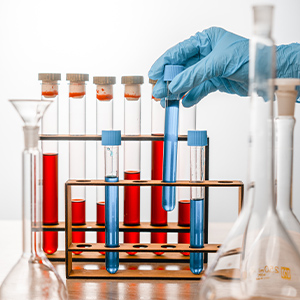
The mobile phase in HPLC is mainly made up of aqueous solvents, organic solvents, or a mixture; aqueous solvents are also commonly used as buffers. Differences in the mobile phase often arise due to differences in what is indicated in the data and the actual preparation method, which affects the chromatogram and analytical results. Solvents are generally mixed by volume ratio (V/V) or weight ratio (W/W). The volume of the solution varies with temperature, so mixing by weight ratio modulates a more reproducible solvent mixture. Still, volumetric mixing is usually used more often because of the more cumbersome handling. Mixing by volume is possible if it is not specifically labeled as such. Still, in special cases, such as mixing solutions with high amine viscosity, weight-to-volume ratios (W/V) are sometimes used.
Liquid chromatography separates sample components by the mass exchange between the column packing and the mobile phase. It, therefore, requires the mobile phase to have the following characteristics.
a. The mobile phase has a certain solubility for the sample to ensure that the sample components do not precipitate in the column (or remain in the column for a long time). If the mobile phase solubility does not meet the requirements, try to use the mobile phase containing a larger proportion of the components to reduce the impact of the mobile phase on the sample to cause baseline instability.
b. The mobile phase does not react chemically with the sample, and the mobile phase configuration is chosen to have the least effect on the chromatographic peak.
c. The viscosity of the mobile phase should be as small as possible to get a good separation effect, reduce the column pressure drop and extend the pump’s life (can be used to increase the temperature of the method to reduce the viscosity of the mobile phase).
d. The physical and chemical properties of the mobile phase should be compatible with the detector used. If using a UV detector, it is best to use a solvent formulation with low UV absorption. When the solvent composition of the mobile phase does not meet the requirements, the solvent selected should ensure no UV absorption within the set wavelength.
e. The mobile phase boiling point should not be too low. Otherwise, it is easy to produce bubbles, resulting in the experiment can not be carried out.
f. After the mobile phase has been prepared, it must be degassed. Removal of trace gases dissolved in the mobile phase is beneficial to detecting and preventing trace oxygen in the mobile phase from interacting with the sample.
Here are 21 notes to make you more knowledgeable about liquid phase mobile phases.
1. Choose the mobile phase accordingly, paying attention to filtering the solvent
The solvent must be filtered through a 0.5 μm HPLC solvent filter before use. Suppose solid chemical reagents (buffer salts) are used to prepare the mobile phase. In that case, filtration is particularly important, so solid particles do not contaminate the pump and block the injector and column cap frit (HPLC frits). The laboratory has water-soluble and fat-soluble filter membranes to choose from (reflective side up). When filtering water-soluble mobile phases (e.g. methanol/water), wet the filter membrane with 1 to 2 mL of methanol to help with rapid pumping.
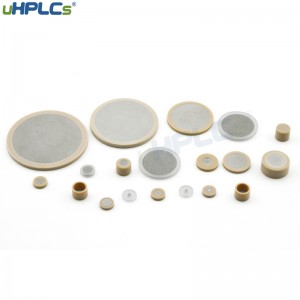
2. Pay attention to keeping the reservoir bottle clean
Using common solvent bottles as mobile phase reservoirs should be discarded from time to time, and the bottles should be cleaned with HPLC-grade water or solvent for the last time without leaving stains during the cleaning process.
3. Pay attention to ensure the quality of the solvent
Must use HPLC grade solvent. Water should also reach HPLC grade and likewise use high-purity buffer salts.
4. Pay attention to inadequate degassing of the mobile phase
The mobile phase is heated, or the mobile phase is mixed with different components, which will have gas bubbles in the pump caused by pressure fluctuations, increased noise, and chromatogram burr. The mobile phase must be degassed beforehand. Otherwise, bubbles will easily escape from the system and affect the work of the pump.
Bubble generation in the system: the mobile phase itself exists, the gradient drenching and mixing after the release of bubbles; the impact of bubbles: the presence of the pipeline, the system pressure is unstable, the experimental results have deviations; the presence of a one-way valve, easy to cause liquid reflux, inaccurate flow, or even the presence of non-absorbent liquid in the detector, the appearance of ghost peaks, affecting the accuracy of detection. So do the liquid phase of the mobile phase bubbles, and impurities requirements are more stringent. Air bubbles can affect the column’s separation efficiency, the detector’s sensitivity, baseline stability, or even make it impossible to detect. (Increased noise, unstable baseline, sudden jumps). In addition, oxygen dissolved in the mobile phase may react with the sample, the mobile phase, or even the stationary phase (e.g. alkylamines). Dissolved gases can also cause changes in solvent pH, introducing errors in the separation or analytical results. Dissolved oxygen can form UV-absorbing complexes with certain solvents (e.g. methanol, tetrahydrofuran), which can increase background absorption (especially below 260 nm) and cause a slight decrease in detection sensitivity, but, more importantly, can cause baseline drift or ghost peaks (false peaks) during gradient washout. In fluorescence detection, dissolved oxygen can also cause quenching under certain conditions, particularly for aromatic hydrocarbons, aliphatic aldehydes, ketones, etc.
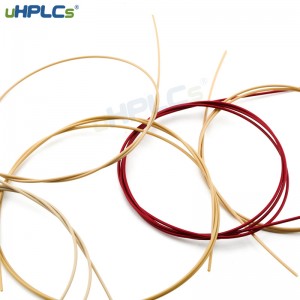
In some cases, the fluorescence response can be reduced by up to 95%. In electrochemical detection (especially in reduction electrochemistry), the effect of oxygen is even greater. Removal of dissolved oxygen from the mobile phase will greatly improve the UV detector’s performance and sensitivity in some fluorescence detection applications.
Commonly used degassing methods are heating and boiling, evacuation, ultrasound, helium blowing, etc. For mixed solvents, if evacuation or boiling is used, the change in composition caused by the evaporation of the low boiling point solvent needs to be considered.
(1) Helium degassing: Helium degassing is a very effective method. Helium gas is slowly driven through the mobile phase to remove the dissolved air and, if used properly, can remove 80% to 90% of the dissolved gas within 10 min. Since the solubility of helium in the mobile phase is extremely low, a mobile phase protected by helium degassing can be considered a gas-free system. The disadvantage is that helium is relatively expensive and can increase the cost of testing. Generally speaking, the gases in organic solvents are easy to remove, while those in aqueous solutions are more stubborn. Blowing helium into the solution is a fairly effective method of degassing, and this continuous method is often used in electrochemical testing. However, helium is expensive and difficult to popularise.
(2) Vacuum degassing: This is also a relatively common method. The reservoir is pumped into a partial vacuum, and the dissolved gas evaporates to form overflow bubbles, second only to helium degassing. In-line degassers are used for liquid chromatography, such as Agileng 1200. In-line degassing is only suitable for the mobile phase after degassing and for micro degassing during use.
(3) Ultrasonic degassing: the prepared mobile connected container is put into the ultrasonic water tank to degas for 10-20 min. This method is relatively simple and can meet the requirements of daily analytical operations, so it is still widely used. This method only removes 30% of the dissolved gas and sometimes causes an increase in gas solubility. This method is not suitable for oxygen-sensitive detectors. Ultrasonic degassing is better. 10-20 minutes of ultrasonication is sufficient for many organic solvents or organic solvent/water mixtures (generally, 500 ml of solution requires 20-30 min of ultrasonication before), there are different opinions on the issue of ultrasonication time, ranging from 5 to 30 minutes within each laboratory, generally speaking, when the mobile phase composition is inorganic (buffered salt solution), 5-15 minutes is sufficient, and when the mobile phase is This method can only remove 30% of the dissolved gas, the extension of time is not proportional to the effect. The bubbles have a certain impact on the stability of the chromatographic peak baseline and signal-to-noise ratio. Generally speaking, the impact is insignificant, but 15 min sonication can be sufficient. This method does not affect the solvent composition. When sonication, you should avoid contact between the solvent bottle and the bottom of the sonication tank or wall so as not to break the glass bottle. The container’s liquid level should not be much higher than the water surface.
(4) Heating reflux degassing: Although this method is very effective, it has a narrow scope of application. Organic solvents or mixed mobile phase is unsuitable for this method because the volatile components will be lost, and the mobile phase’s composition will change.
On balance, vacuum filtration followed by ultrasonic degassing is still the most common method, with helium being the most effective method, while online degassing is itself vacuum degassing. Still, it can be used on an instrument and is a guaranteed method.
A. The off-line (off-system) degassing method does not maintain the solvent in a degassed state, and the gas returns to the solvent immediately after you stop degassing. Within 1 to 4 hours, the solvent will again be saturated with ambient gas.
B. In-line (in-system) degassing does not have this disadvantage. The most commonly used in-line degassing method is bubbling, where an inert gas is sprayed into the solvent before and while the chromatography operation is in progress. Strictly speaking, this method does not degas the solvent. It replaces the air with a low-solubility inert gas (usually helium). In-line degassers are also available.
5. Pay attention to the poor supply of mobile phase
When the mobile phase is used up, the pump pressure is unstable due to gas inhalation in the pipeline. The amount of mobile phase in the reservoir should be frequently observed, and sufficient mobile phase should be added to ensure that all samples are analyzed. The sinker on the pipeline is sunk to the bottom of the bottle, and a small hole is left in the reservoir lid to clamp the inlet tube so that it cannot move up or down.
Clogged filters cause cavitation in the tubing and pump chamber and unstable pressure. If the system operates normally after removing the hplc solvent filter, the problem has been identified, and the solvent filter can be replaced with a new one. Sometimes, if a new inlet solvent filter is still not working well, the mobile phase preparation process needs to be investigated, or a larger pore-size inlet solvent filter needs to be replaced. In any case, the mobile phase needs to be refiltered. High flow rates and resistance cause cavitation caused by the filter pore size, inner pipe diameter, flow rate, and solvent viscosity. This phenomenon often occurs if the flow rate exceeds 10 mL/min.
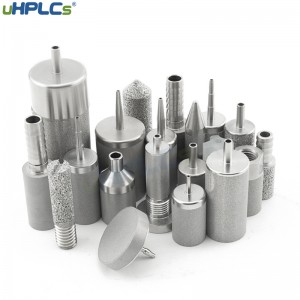
Use the following methods to resolve.
(1) Use a low flow rate.
(2) Change the filter to a larger orifice.
(3) Increase the internal diameter of the inlet pipe.
(4) Raising or pressurizing the reservoir.
(5) Don’t use an inlet solvent filter, but the mobile phase must be filtered first.
(6) The reservoir lid is too tight, creating a vacuum and discontinuity in the mobile phase. The lid should be loosened, or a gap of 1 mm should be left.
(7) The liquid inlet pipe is blocked or bent so that the pump cannot pump the liquid. Please pay attention to adjusting the liquid inlet pipe or replacing it with a new one. Other problems include leakage or loose joints, damaged pump parts, etc., which can cause abnormal liquid supply.
6. Pay attention to preventing the mobile phase and reservoir from being contaminated
Due to contamination, noise is increasing, and the detector baseline rises. Contaminants may be pumped into the system at a stable concentration and then flow out at a stable concentration so there are no excess peaks in the chromatogram. With gradient elution, a weak mobile phase can cause contaminants to cluster at the top of the column, and as the mobile phase strength increases, the contaminants may be eluted out as a large pseudo-peak. Sometimes a sudden increase in baseline noise or a sudden rise in noise can be caused by repeatedly adding a new mobile phase or using the system for too long (overnight).
The newly added mobile phase has contaminants, or the mobile phase is moldy and colonized with bacteria. A dirty reservoir can contaminate a clean mobile phase. Each mobile phase has a dedicated reservoir, or the reservoirs are disposed of periodically.
Mobile phase contamination comes from several sources: poor quality reagents and substandard glassware; the influence of microorganisms; and improper handling when preparing the mobile phase, so high-purity chemicals and HPLC-grade solvents are required. To prevent the growth of microorganisms, the system should be cleaned daily with methanol. The system should be cleaned daily with methanol; if microorganisms are suspected of having grown in the system, dilute nitric acid can be used to flush them out (taking care not to damage the column and piping system); pump oil should be prevented from being carried into the mobile phase during vacuum degassing; clean inert plugs, stirrers, filters, and glassware should be used to prepare the mobile phase; and contaminated mobile phase should always be discarded.
7. Pay attention to the selection of mobile accordingly does not change the packing any nature
Low cross-linked ion exchange resins and exclusion chromatography fillers sometimes swell or shrink when they encounter certain organic phases, thus changing the nature of the column bed. Alkaline mobile phases should not be used in silica gel column systems. The acid mobile phase can not be used for alumina, magnesium oxide, and other adsorbents column system.
8. Select the corresponding mobile attention to purity
HPLC column life with many mobile phases through the related, especially when the impurities contained in the solvent in the column accumulate.
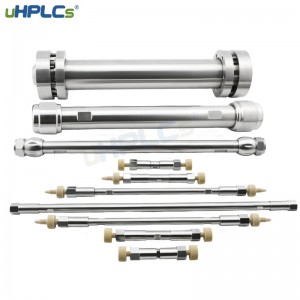
9. The selection of corresponding mobile attention must be matched with the detector
When using a UV detector, the mobile phase should have no absorption at the detection wavelength or very little absorption. When using a differential refractive index detector, the refractive index should be selected with the sample difference between the solvent for the mobile phase to improve sensitivity.
10. Select the mobile phase should pay attention to low viscosity (should be <2cp)
High viscosity solvent will affect the solute diffusion, and mass transfer, reduce column efficiency, but also increase the column pressure drop so that the separation time is extended, the best choice of mobile phase boiling point below 100 ℃.
11. Select the mobile phase corresponding to the attention of the sample solubility to appropriate
If the solubility is not good, the sample will be precipitated in the HPLC column head, not only affecting the purification of the separation, and will make the LC column deteriorate.
12. The selection of corresponding mobile attention to the sample is easy to recover
volatile solvents should be selected
13. The choice of flow corresponding attention from strong to weak
Generally, first, use 90% of acetonitrile (or methanol)/water (or buffer solution) for the test so that the separation results can be obtained quickly, and then adjust the proportion of organic solvent (acetonitrile or methanol) according to the peak situation.
14. Select the flow accordingly, paying attention to the rule of thirds
For every 10% reduction in organic solvent (methanol or acetonitrile), the retention factor increases approximately three times; this is the rule of thirds. This is a clever and labor-saving approach. During the adjustment, pay attention to the separation of the individual peaks.
15. Select the flow accordingly, paying attention to coarse adjustment to fine adjustment
When the separation reaches a certain level, the organic solvent 10% change should be adjusted to 5% and gradually reduced, the adjustment rate according to this rule, until the separation of the components no longer changes.
16. The mobile phase preparation attention to the organic solvent and aqueous solvent mixing method
Organic solvents and aqueous solvent mixture as the mobile phase often, but due to different mixing methods, sometimes the analytical results vary greatly. For example, if the mixture of 20mM sodium phosphate buffer (pH 2.5) 90% and acetonitrile 10%, the mixing ratio is 9:1 when the volume ratio of 20mM sodium phosphate buffer (pH 2.5) 90% and acetonitrile 10% is 9:1, which means that it can be interpreted as each being mixed after weighing an equivalent amount according to the volume ratio. Alternatively, an interpretation based on 10% acetonitrile, using 20 mM sodium phosphate buffer (pH 2.5) and diluting the acetonitrile to make up the mixture, could also be justified. In the latter case, a reduced mixture volume is produced, and the remainder is added with 20 mM sodium phosphate buffer. Although there is not much difference between the two, the analytical results, especially the retention time, can differ significantly due to the different mixing methods, which must be noted.
17. Preparation of 50% or (V/V = 1/1) aqueous acetonitrile solution
For preparing aqueous solutions of acetonitrile with V/V = 1/1, according to this method:
- 500mL of acetonitrile measured in a measuring cylinder
- 500mL of water measured in another measuring cylinder
- The two liquids were mixed in the bottle with a good shaking
However, when the 50% aqueous acetonitrile solution is expressed, it is mostly prepared in the above way. Still, when checking the chemical dictionary, it is prepared in this way: first, 500mL of acetonitrile into a 1L measuring flask, the measuring flask is stirred while adding water, and when the liquid temperature reaches room temperature, the full amount of water is used to bring the solution to 1L. in this way, expressed in % and “V/V ” volume ratio, the final result is a different mobile phase composition. That is, the density of the mixed solvent is not the same as the simple average calculated from the density of the original solvent, so the mobile phase composition modulated by the two methods described above differs. If at room temperature (25 ℃) near the water, 50mL and acetonitrile 50mL mixed volume is not 100mL, but reduced, about 96mL. In general, easier to use the first method.
18. The mobile phase of the preparation of attention to the solvent volume of the temperature effect
The surrounding temperature influences the density of the solution. Just taken out of the solvent freezer solution temperature compared with the laboratory room temperature, to be quite low, acetonitrile and water mixture due to heat reaction, the solution temperature increases. Therefore, to modulate a reproducible mobile phase, it is recommended that the solution temperature be adjusted to room temperature using a constant temperature water bath before use.
19. The mobile phase preparation attention with two pumps for solvent mixing
The double pump mainly explores the mobile phase ratio, or gradient elution is more convenient. Knowing the exact liquid chromatograph conditions, it is recommended to use the words after the preparation, and if the mixture is more uniform, the effect is better. In reversed-phase analysis, the commonly used method of equal concentration of organic solvents and water, the use of a high-pressure two-element gradient system, with two pumps to mix the mobile phase after separate infusion and other closed mixing with pre-mixing in the bottle after infusion with 1 pump, because of the different volume change after mixing, retention time is also different, must be noted. These problems are often found in the preparation of fluidity and the preparation of specimen solutions and other solutions. In addition, different sectors (pharmaceutical or chemical) each have their common sense and customs. In this case, it is required that each department can stipulate general rules when producing suitable solution preparation methods and define the modulation methods of the designed solutions to avoid confusion and to remember these representations in their daily work better.
20. Pay attention to the pH of the mobile phase
The mobile phase’s pH must be regularly measured if it is to be operated at a certain pH value. Atmospheric CO2 dissolved in the mobile phase will cause a change in the pH value, especially when the reservoir bottle is not tightly closed.
21. Pay attention to the replacement of the column and mobile phase
The swelling rate of soft or semi-soft packing varies with the polarity of the solvent. The mobile phase should be balanced with 25~30 times the column volume when using a new column. If the two mobile phases are not mutually soluble, a transition solvent should gradually dissolve the former mobile phase when replacing the mobile phase. For example, when changing from 2,2,4-trimethylpentane to methanol, the transition must be made with acetate or another solvent until the retention value of the standard reaches a steady state.
Post time: Feb-18-2023






